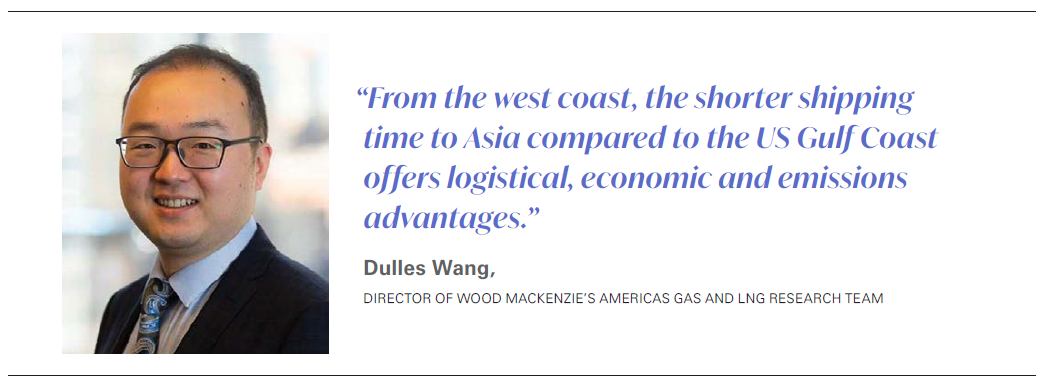Reports of demise of Canadian LNG premature [Gas in Transition]
A decade ago, more than a dozen LNG export projects were proposed for Canada’s west coast, promising the potential for a C$100bn industry in BC.
Fast forward to today, and LNG Canada, a C$40bn project fronted by Shell, is the last project standing. Its 14mn metric tons/year first phase is under construction, targeting completion in 2025; a matching second phase is under consideration, but facing environmental headwinds as BC seeks to reduce its carbon footprint.
Since the LNG Canada consortium took a final investment decision in 2018, a few other smaller export projects – Woodfibre LNG and Cedar LNG the most advanced – have popped up.
As all-electric liquefaction facilities, they fit within BC’s carbon budget, as does LNG Canada’s first phase, but there has been considerable debate whether any other Canadian projects will ever materialize.
But Dulles Wang, director of gas and LNG research at global consultancy Wood Mackenzie, tells NGW there is a case to be made for future LNG developments on the west coast, even with high costs associated with greenfield projects in remote locations.
“There are still promises for Canadian projects, especially with the changing global market dynamics,” he says. “From the west coast, the shorter shipping time to Asia compared to the US Gulf Coast offers logistical, economic and emissions advantages.”
And since many of the newer projects – including Woodfibre LNG and Cedar LNG – are built on modular, floating platforms powered by renewable electricity, they can meet both economic and environmental demands for new LNG supply.
“These changes could potentially offer a pathway for new greenfield development in western Canada,” Wang says. “International players with major upstream positions will continue to screen LNG opportunities, and projects that were unsuccessful in the past provide experience of what could be done differently to succeed in the future.”
What hasn’t changed in all the years LNG has been contemplated in Canada is the quality of the resource. LNG Canada, Woodfibre LNG and Cedar LNG will all draw from the world-class Montney shale gas play in northeastern BC – one of the lowest-cost basins in North America, Wang says.
“The Montney is one of the most prolific shale plays in North America, with an estimated 185 trillion ft3 of gas resource potential, and most of the play breaks even at less than US$2/mn Btu,” he says.
LNG Canada will take about 1.8bn ft3/day; Cedar LNG, another 300mn ft3/day, and Woodfibre LNG about 400mn ft3/day. That leaves plenty of running room for future projects, like the proposed 12mn mt/yr Ksi Lisims project being advanced by the Nisga’a Nation, with help from a consortium of Montney producers.
“The Montney holds more than enough resources to support a substantial build-out of new LNG liquefaction projects,” Wang says. “But the key will be having adequate pipeline infrastructure – brownfield expansion or greenfield – to connect growing supply to the future LNG projects.”
LNG Canada and Cedar LNG will be supplied through the 2.1bn ft3/day Coastal GasLink pipeline, and a second phase at LNG Canada, should it move forward, will be supplied by adding compression to the CGL system.
Woodfibre LNG will get its gas from the existing Westcoast transmission system in BC, which is owned by Enbridge – a 30% equity partner in Woodfibre.
Even Ksi Lisims has advanced pipeline projects it can turn to: both the Westcoast Connector Gas Transmission Project (another Enbridge project) and the Prince Rupert Gas Transmission project (by TC Energy, which is building CGL), which were originally intended to supply now-shelved liquefaction projects, have been approved at the federal and provincial level.
What remains a challenge for any future LNG project in Canada is regulatory and policy certainty. A key component of that certainty was resolved recently, when the BC government and a number of First Nations impacted by Montney developments reached an agreement on how the resource there would be managed moving forward.
“Respecting First Nations’ treaty rights is a fundamental pillar of Canadian society, and the year-and-half regulatory uncertainty in BC impacted upstream development in the Montney in 2022,” Wang says. “The latest agreement with the Blueberry River First Nations, and others, provides the much-needed regulatory certainty and a roadmap on how resources can be developed more sustainability going forward.”
The agreements limit how much new land can be disturbed by future resource developments, but importantly do not put a cap on the amount of the Montney resource that can be developed, Wang notes.
“Canadian upstream producers have already been driving innovation in their operations with practices such as shifting to longer wells to account for land disturbance and self-certifying operations through third party agencies to produce responsibility sourced gas,” he says. “We’re optimistic that with continued process improvement and innovation in the upstream sector, there will not be much downside impact on the BC Montney’s ability to meet feed gas needs for future LNG projects in western Canada.”



